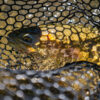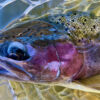The fishing scene around the valley is about to take a dramatic turn in the coming week or two. A significant change in the weather is settling in on us and remnant dry fly opportunities are quickly fading. Before the big midge hatches of winter we always enter a phase where nymphing and streamer fishing comes to the forefront of most angling days. A warm coat, perhaps gloves and a hat and an adventurous spirit will be required as winter sets in. The good news – There is hardly anything finer than a brisk day on a deserted trout stream capped off with warm mugs of spiked cider, a cool ale or a hot tea with a fire pumping out much needed warmth and the sounds of football, friends and family in the background. Après fishing at its finest!
Silver Creek
Cooler temperatures are going to slow the fishing quite a bit, but significant cloud cover means a calm afternoon could still produce good hatch activity. Since serious Silver Creek anglers don’t spend a lot of time nymphing and streamer fishing the moving water at Silver Creek (being the dry fly Mecca that it is), spending a whole day on this river may not be the best choice. Instead, look at the weather forecast, and try to find the warmest day and time of day that you can, and then spend a few afternoon hours looking for a hatch and some rising fish. If you can find risers count on them feeding primarily on Baetis and Midges. The rest of the day, or on fouler days, think about fishing the Big Wood or the nearby Little Wood River with nymphs or big attractor patterns. The sloughs at Silver Creek are another good option if the river is slow. Pulling nymphs through the hot spots in the sloughs is a common tactic and with good, realistic nymph patterns in small sizes, an angler can have a ton of fun over these Stillwater areas.
Big Wood River
The Wood is still producing good surface activity, but inclement weather is going to impact this fishery. A big Cripple Fly, like a Green Drake or Brown Drake will bring up the remaining fish that are still looking for the Red Quill, and breaks in the weather could produce decent Baetis activity, but for the most part plan on nymphing under a strike indicator with small nymphs like Copper Johns, Pheasant Tails, and Zebra Midges, or swing bigger flies downstream like Prince Nymphs, Hare’s Ears, and Zug Bugs. Anglers that enjoy streamer fishing will find trout paying more and more attention to Sculpin imitations and this is always a good choice if you are out in the worst weather. Even under cold and rainy conditions a well presented streamer will take nice size fish.
Lost River
The Lost is running extremely low, thus concentrating the fish into the deepest areas. Presenting small nymphs under a strike indicator is going to bring a few to the net. The darker and fouler the day, the more likely it is to catch more numbers and bigger fish. Be prepared for some hard fighters as these fish were well exercised under the continuous high flows of the summer months. Expect fish to take Pheasant Tails, San Juan Worms, Prince Nymphs and a variety of Bead Head Midge imitations. Classic streamer flies will also produce nice fish, try Muddler Minnows, Matukas, and Royal Coachmen. With the pools as low and still as they have been in a long time, keep your approach and presentation as subtle as possible, the rocky nature of the river bottom makes for a lot of noise when in a hurry, so take your time, fish long leaders and enjoy one of the quietest times of the year on the Lost.
Upper Lost River and Copper Basin
The upper Lost is still producing nice catches and underutilized water. Low flows mean long stretches of river can be covered with relative ease. Covering long stretches is the best way to fish this river. Bring a friend and two vehicles or a bicycle to run a shuttle with, pack a lunch and enjoy a long upstream angling adventure. Fish attractor patterns like Wulffs and Trudes or try nymphing with a shallow water set up. Two feet is plenty of distance between a nymph and indicator under the current conditions. Copper Basin is still fishing, although lower flows and lower temperatures will have fish heading to the deeper, down stream sections.
Little Wood River
The Little Wood still looks very good throughout the system. This is a great time of year to explore the desert stretches of this river. Fishing shallow water nymph rigs through turbulent areas is a great tactic in this area, as well as casting streamers to the edge of lava rock shelves and ledges. The upper Little Wood above the reservoir is rarely being fished and is also a good place to nymph with small Bead Head patterns under a strike indicator.
South Fork of the Boise
The lower altitude and warmer day time temperatures of the South Fork means there is still a good opportunity to see great Baetis activity on the river. It is not uncommon to see this activity well into November. When fish aren’t rising, try nymphing with Midge imitations and Cased Caddis imitations as well. The flows are low and wade fishing access is very easy right now, so if you don’t own a drift boat and have always wondered about fishing the South Fork, this is your time of year, take advantage of it!
WATER CONDITIONS
Basin Precip. Averages
Salmon – 68%
Big Wood – 54%
Little Wood – 49%
Big Lost – 57%
Henry’s Fork – 81%



